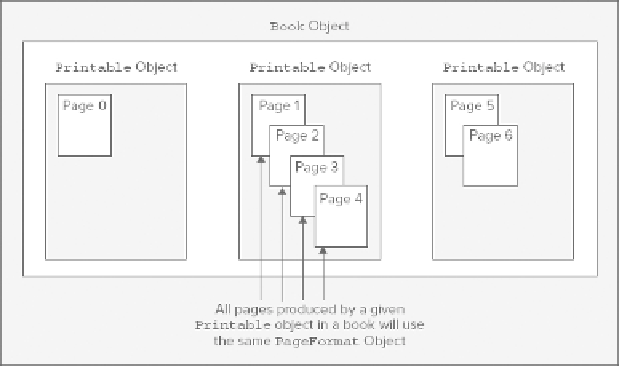Java Reference
In-Depth Information
Because the
Book
class implements the
Pageable
interface, you print a book in the same way as you
print a
Pageable
object. After you have assembled all the pages you want in a
Book
object, you just pass a
reference to it to the
setPageable()
method for your
PrinterJob
object. Let's take it from the top.
The
Book
class has only a default constructor and that creates an empty book. Thus, you create a book
like this:
Book sketchBook = new Book();
You add a page to a book by calling the
append()
method for the
Book
object. There are two overloaded
versions of
append()
: one to add a
Printable
object that represents a single page, and the other to add a
Printable
object that represents several pages. In the latter case, all the pages are printed using the same
PageFormat
object.
The first version of
append()
accepts two arguments: a reference to the
Printable
object and a reference
to an associated
PageFormat
object. This means each page in a book can have its own formatting. Suppose
you want to create a
Book
object for Sketcher, and the object would be created in the
SketcherFrame
object
somewhere. You could add the cover page of a sketch just as in the previous example to the
sketchBook
object like this:
PageFormat pageFormat = pageFormat.clone();
Paper paper = pageFormat.getPaper();
double leftMargin = paper.getImageableX(); // Top left corner is indented
double topMargin = paper.getImageableY(); // by the left and top margins
double rightMargin = paper.getWidth()-paper.getImageableWidth()-leftMargin;
double bottomMargin = paper.getHeight()-paper.getImageableHeight()-topMargin;
leftMargin *= 2.0; // Double the left margin...
rightMargin *= 2.0; // ...and the right...
topMargin *= 2.0; // ...and the top...
bottomMargin *= 2.0; // ...and the bottom
paper.setImageableArea(leftMargin, topMargin, // Set new printable area
paper.getWidth()-leftMargin-rightMargin,
paper.getHeight()-topMargin-bottomMargin);
pageFormat.setPaper(paper); // Restore the paper

